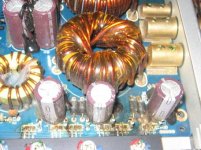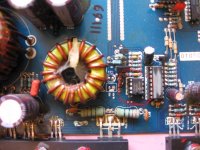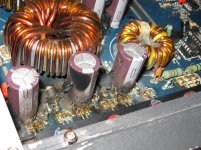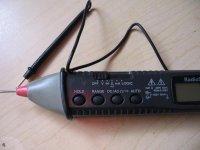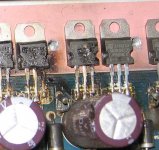The 3-legged devices under the clamps in your photo are MOSFETs. They are likely RFP70N06s. When these fail, the MIC4424/TC4424 driver IC (IC8) and the 10 ohm gate resistors often fail also.
It's likely that you also have shorted output transistors.
It's likely that you also have shorted output transistors.
Im learning as i go along in this so i appreciate the help....Thank you...Did you think i should be concerned about the capacitors any?
Im thinking my plan of action is going to be is to replace as you said the MIC4424/TC4424 driver IC and then, All Mosfets, output transistors and resistors just to be on the safe side.
1) Would suggest i go with higher quality mosfet piece since i compete with this amp?
2) As far as purchasing these parts...where would you suggest?
3) What do you think of what was said in this article about this amp in reference to the going from an 85*c to a 105*c for the main supply filters?
"Circuit layout is also clean. The power supply uses two main toroid transformers in its unregulated design. Of the group, Earthquake's overall efficiency was the highest.
There is no fusing, except an internal 30-amp fuse on the speaker output. Earthquake elected to use 85*C capacitors for their main supply filters. As we've pointed out in previous reviews, we feel that this is simply too low in any automotive design, and that 105*C capacitors should be used"
1) Would suggest i go with higher quality mosfet piece since i compete with this amp?
2) As far as purchasing these parts...where would you suggest?
3) What do you think of what was said in this article about this amp in reference to the going from an 85*c to a 105*c for the main supply filters?
"Circuit layout is also clean. The power supply uses two main toroid transformers in its unregulated design. Of the group, Earthquake's overall efficiency was the highest.
There is no fusing, except an internal 30-amp fuse on the speaker output. Earthquake elected to use 85*C capacitors for their main supply filters. As we've pointed out in previous reviews, we feel that this is simply too low in any automotive design, and that 105*C capacitors should be used"
You need to check the output transistors. If they're not defective, do NOT replace them.
I wouldn't use the 85c caps on the primary side of the power supply but if they didn't fail, they have been OK for many years. If you are going to replace them, I'd recommend the FC series sold by Digikey.
I'd suggest using exact replacement parts.
Digikey should have all the parts you need for the power supply.
http://search.digikey.com/scripts/DkSearch/dksus.dll?Detail&name=RFP70N06-ND
http://search.digikey.com/scripts/DkSearch/dksus.dll?Detail&name=576-1199-ND
You'll have to measure the capacitors to order the correct replacements.
I wouldn't use the 85c caps on the primary side of the power supply but if they didn't fail, they have been OK for many years. If you are going to replace them, I'd recommend the FC series sold by Digikey.
I'd suggest using exact replacement parts.
Digikey should have all the parts you need for the power supply.
http://search.digikey.com/scripts/DkSearch/dksus.dll?Detail&name=RFP70N06-ND
http://search.digikey.com/scripts/DkSearch/dksus.dll?Detail&name=576-1199-ND
You'll have to measure the capacitors to order the correct replacements.
Sounds good.... Perry, i will check them out first. Thank you!!! I will I must say , I am nervous but willing. This will be my first operation. Im going to order the parts tommorow. I get you the pics as soon as i can.
yes, the ones that perrybabin states can be used but the crossreference ones i used was IRF1010 and make sure you change the TC4424cpa ic and check the gate resistors, thats just for the power section. check your output fets i think its 40N06 if there is any short, and have a 13.8 powersupply with atleast 5amp just to start up without much feedback power if there is any short that is overlooked, by the way 6 fets in the powersupply stage can juice up your output to produce sound if in any doubts.
ok guys.... let me know if i did it right, i set my meter to 0.L m-(ohms) for mega-ohms
1) I checked the mosfets on the power side to see what mega-ohms readings i was getting and all of them read 0.00, (no resistance)
2)On the output side of the mosfets i get readings of 6.35 , .23 , and o.oo . What does this mean?
3)I could not locate the MIC4424/TC4424 driver IC and 10 ohm gate resistors but i did locate the "IC8" chip. See pic below
1) I checked the mosfets on the power side to see what mega-ohms readings i was getting and all of them read 0.00, (no resistance)
2)On the output side of the mosfets i get readings of 6.35 , .23 , and o.oo . What does this mean?
3)I could not locate the MIC4424/TC4424 driver IC and 10 ohm gate resistors but i did locate the "IC8" chip. See pic below
Attachments
1. You should have had the meter set to diode-check mode.
2. I don't know how you got those readings. Where were the probes for each of the numbers you posted?
3. IC8 is the TC4424. The 10 ohm gate resistors are connected to the first leg of each of the power supply FETs.
2. I don't know how you got those readings. Where were the probes for each of the numbers you posted?
3. IC8 is the TC4424. The 10 ohm gate resistors are connected to the first leg of each of the power supply FETs.
Ok Mvap, lets begin here, if you are testing for those fet readings the megaohms would be too high if your tester is on a manual setting, not saying you did not get zeros on the powerfet reading, but what if the megaohm reading did not resolute to the lower ohm (in other words the reading did not reflect the tester).
Getting zeros at a lower scale is a case where the fets are destroyed. and a sign of fireworks in that area is definately no good fets.
The readings you got for your output fets sounds ok, in regards to the zero reading you got, is from the output resistor (generally 0.22ohms)p.s. there we go again base on your multimeter tester you wont get the .22 reading if your setting is too high.
The chip you have circled in the pic is definately the tc4424cpa chip which is indeed IC8, as for the gate resistors they are located near the powerfets a 10ohms color code would be :brown:black:black
Fourthly my instincts tells me you are not capable enough of fixing this amp, you could end up doing more damages, there are more complex issues that goes way beyond rocking a few fets.
Getting zeros at a lower scale is a case where the fets are destroyed. and a sign of fireworks in that area is definately no good fets.
The readings you got for your output fets sounds ok, in regards to the zero reading you got, is from the output resistor (generally 0.22ohms)p.s. there we go again base on your multimeter tester you wont get the .22 reading if your setting is too high.
The chip you have circled in the pic is definately the tc4424cpa chip which is indeed IC8, as for the gate resistors they are located near the powerfets a 10ohms color code would be :brown:black:black
Fourthly my instincts tells me you are not capable enough of fixing this amp, you could end up doing more damages, there are more complex issues that goes way beyond rocking a few fets.
Well Formas... I never claimed to be an expert at this, just a person who likes the electronics of amplifiers and wants to learn as he goes along fixing his own. I figured since this forum dealt with the Phd2 and fixing them this would be the place to learn. Just to mention I do not only use this website only, I search other sites for knowledge as well. I hope I have not aggravated anyone, it was not my intention. I just want to do it myself. So if you are inclined to lend your knowledge then, please, by all means do so. However, if you do not want to, then I completely understand. Or if there is someplace I can go that's for beginners like myself, could you point me in that direction? Anyones assistance in the matter would be greatly appreciated.
Just to answer you PERRY... I used the probes on the outter legs of the fets (neg on the left and pos on the right). I do not have a sophiscated meter, but im looking into one, i have heard in the pass that fluke is a good brand to go with.
Does your meter have a diode check function?
What make/model meter is it?
Fluke is my meter of choice. For this type of work, I prefer the models 10, 11 and 12.
The capacitors look OK. If they're not swollen on the top and aren't leaking, they're 'generally' OK.
What make/model meter is it?
Fluke is my meter of choice. For this type of work, I prefer the models 10, 11 and 12.
The capacitors look OK. If they're not swollen on the top and aren't leaking, they're 'generally' OK.
Set it to diode check (diode symbol) and touch the probes together. It should read all zeros. If you read anything similar between any two legs of any individual output transistor (FET), the transistor likely defective. If all readings are above ~0.4, they're likely OK.
- Home
- General Interest
- Car Audio
- Earthquake PHD2 seems to lower output???
